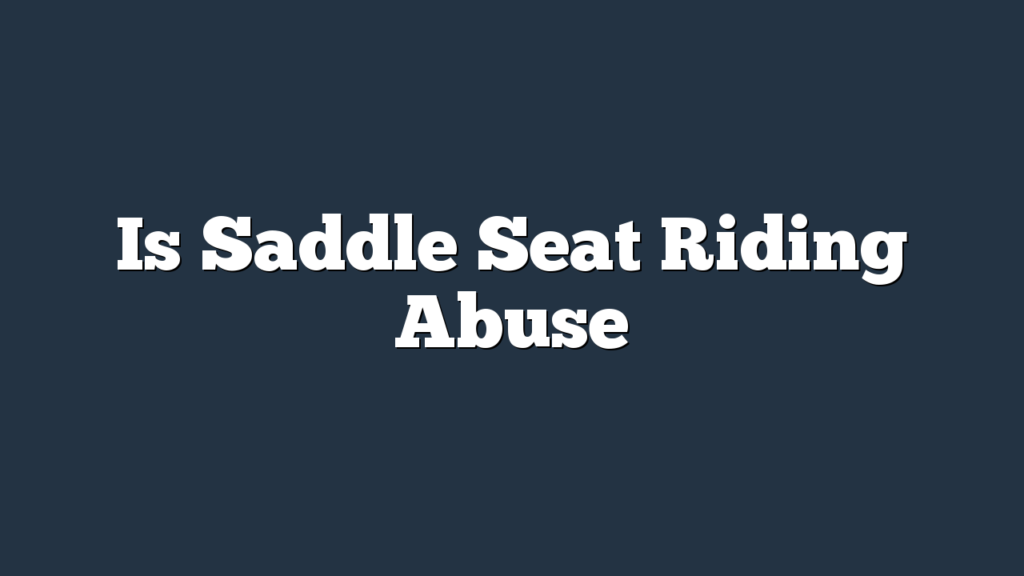Do you wonder if saddle seat riding is a form of abuse?
In this article, we’ll explore the controversial topic and shed light on the potential impacts on horse health and well-being.
From the historical background to the use of specialized equipment, we’ll examine various aspects and expert opinions to help you form a balanced perspective.
So, let’s dive into the debate and find out if saddle seat riding is considered abuse or a legitimate practice.
Historical Background of Saddle Seat Riding
In the world of horseback riding, understanding the historical background of saddle seat riding is essential. Saddle seat riding has undergone an evolutionary development over the years, shaping it into the discipline we know today. This style of riding has a rich cultural significance that dates back to the early 19th century.
Originally, saddle seat riding emerged as a way to showcase the elegance and grace of high-stepping horses, particularly the American Saddlebred breed. The discipline gained popularity in the United States, becoming a symbol of prestige and sophistication. It was often associated with the upper class and was commonly seen in horse shows and exhibitions.
The historical background of saddle seat riding also reveals its roots in the equitation style of the English riding tradition. It combines elements of dressage, show jumping, and pleasure riding, resulting in a unique and distinctive form of horsemanship.
Understanding the evolutionary development and cultural significance of saddle seat riding provides valuable insight into its techniques and purpose. It highlights the discipline’s evolution from a sport of the elite to a widely practiced style of riding. By delving into its history, riders and enthusiasts can gain a deeper appreciation for the artistry and skill required in saddle seat riding.
Training Methods and Techniques Used
Now let’s talk about the training methods and techniques used in saddle seat riding.
It’s important to consider the ethical training practices employed in this discipline and their impact on horse welfare.
Ethical Training Practices
You should consider the ethical training practices used in saddle seat riding. When it comes to horse training, it is important to prioritize the well-being and safety of the animals involved. Ethical considerations play a crucial role in determining the training methods and techniques used in saddle seat riding. Here is a table outlining some ethical training practices that should be followed:
| Ethical Training Practices |
|---|
| 1. Positive reinforcement |
| 2. Clear communication |
| 3. Consistency |
| 4. Proper horse care |
Positive reinforcement involves rewarding the horse for desired behavior, instead of relying on punishment or force. Clear communication ensures that the horse understands what is expected of them, reducing confusion and stress. Consistency in training methods helps the horse to learn and retain information effectively. Proper horse care, including providing adequate rest, nutrition, and veterinary care, is essential for their overall well-being. By following these ethical training practices, saddle seat riders can ensure that the training process is fair, humane, and respectful to the horses involved.
Impact on Horse Welfare
Continuing the discussion, it’s important to examine the impact of training methods and techniques used in saddle seat riding on horse welfare. The way horses are trained and handled can have a significant effect on their behavior and overall well-being. Here are some key points to consider:
- Horse behavior: The training methods used in saddle seat riding should take into account the natural behavior of horses. Understanding their instincts, communication methods, and social structure is crucial in order to train them effectively and without causing undue stress or discomfort.
- Rider responsibility: Riders have a responsibility to ensure the welfare of the horse during training. This includes using humane training techniques, providing proper care, and monitoring the horse’s physical and mental well-being. It’s essential for riders to be knowledgeable about horse behavior and to continually assess their training methods to ensure they aren’t causing harm or distress.
- Impact on horse welfare: The training techniques used in saddle seat riding should prioritize the welfare of the horse above all else. This means avoiding harsh or abusive methods, providing appropriate rest and recovery periods, and considering the horse’s individual needs and limitations. By prioritizing horse welfare, trainers and riders can create a positive and respectful partnership with their horses.
Impact of Saddle Seat Riding on Horse Health
During the practice of saddle seat riding, the constant pressure exerted on the horse’s back can have a detrimental impact on their long-term health. The horse’s well-being is compromised as the repetitive strain on their back can lead to various health effects.
One of the most common issues is the development of soreness and muscle tension in the back, which can cause discomfort and pain for the horse. This can lead to a decrease in performance and overall quality of life for the animal.
Furthermore, the constant pressure on the horse’s back can also result in the compression of the spinal discs. This compression can lead to disc degeneration and even spinal misalignment over time. Such conditions can cause chronic pain and limited mobility, severely affecting the horse’s ability to perform and enjoy their daily activities.
In addition, the repetitive nature of saddle seat riding can lead to the development of pressure sores and skin irritations on the horse’s back. These sores can be painful and can lead to further complications if not properly treated.
The Debate on the Use of Specialized Equipment
Now it’s time to consider the debate surrounding the use of specialized equipment in saddle seat riding.
Some argue that certain equipment is effective in enhancing performance and achieving desired results, while others question the ethical implications of relying on such gear.
The effectiveness and ethical considerations of specialized equipment in saddle seat riding are points of contention that need to be explored.
Equipment Effectiveness Debated
You can debate the effectiveness of specialized equipment used in saddle seat riding. While some argue that these specialized tools enhance the rider’s performance and provide better control over the horse, others believe that they can cause controversy and discomfort.
Here are three points to consider:
- Equipment controversy: One side of the debate argues that specialized equipment, such as high-set saddles and weighted tail sets, can create an unnatural and uncomfortable riding experience for the horse. They believe that this can lead to physical and emotional distress for the animal.
- Rider discomfort: On the other hand, proponents of specialized equipment argue that it helps riders maintain balance and stability, enhancing their overall performance. However, critics claim that some of these tools, like the high-set saddles, can cause discomfort and pain for the rider, especially during long periods of riding.
- Finding a balance: It’s important to find a balance between using specialized equipment and ensuring the well-being of both the horse and the rider. Striking a compromise that prioritizes the comfort and safety of both parties is crucial in the ongoing debate surrounding the effectiveness of specialized equipment in saddle seat riding.
Ethical Implications of Equipment
One major ethical implication of using specialized equipment in saddle seat riding is the debate surrounding the effectiveness of these tools.
The equipment controversy revolves around whether these specialized tools are necessary for the sport or if they cause unnecessary discomfort or harm to the horse.
Some argue that the use of specialized equipment, such as high-action saddles or weighted shoes, enhances the horse’s performance and creates the desired aesthetic. However, others argue that these tools can be harmful to the horse’s physical and mental well-being.
Ethical considerations come into play when determining whether the potential benefits of using specialized equipment outweigh the potential risks and discomfort it may cause to the horse.
This debate highlights the importance of prioritizing the welfare and ethical treatment of the horse in saddle seat riding.
Psychological Effects on Horses in Saddle Seat Riding
While participating in saddle seat riding, horses can experience various psychological effects. It’s important to understand the impact this type of riding can have on a horse’s behavior and how the rider’s influence plays a role in shaping their mental state.
Here are three key points to consider:
- Stress and Anxiety: Saddle seat riding involves high energy and exaggerated movements, which can cause stress and anxiety in horses. The constant pressure to perform at a certain level can lead to heightened emotions and nervousness.
- Trust and Confidence: A horse’s trust in their rider is crucial for their mental well-being. If a rider is inconsistent or harsh in their training methods, it can erode the horse’s trust and confidence. This can result in behavioral issues such as refusal to perform or even aggression.
- Bond and Connection: Horses are social animals and thrive on forming strong bonds with their riders. Saddle seat riding can either enhance this bond or damage it. Positive reinforcement, clear communication, and a mutual understanding between horse and rider are essential for building a strong connection.
Understanding these psychological effects is crucial in ensuring the well-being of horses in saddle seat riding. It’s the responsibility of riders and trainers to prioritize the mental health of their equine partners and create a positive and supportive environment for them to thrive in.
Expert Opinions on Saddle Seat Riding as Abuse
Experts in the equestrian community have differing opinions on whether saddle seat riding can be classified as abuse. While some experts argue that this style of riding can have negative effects on horse welfare, others believe that it can be practiced responsibly without causing harm. Let’s take a closer look at the expert opinions and their perspectives on the matter.
The table below provides a summary of the main arguments put forth by these experts:
| Expert Opinion | Horse Welfare |
|---|---|
| Proponents argue that saddle seat riding, when done correctly, does not cause harm to horses and can even improve their overall fitness and muscle development. They emphasize the importance of proper training and horsemanship skills. | They argue that saddle seat riding can put excessive pressure on the horse’s back and legs, leading to discomfort, pain, and even long-term damage. They advocate for a more natural riding style that allows the horse to move freely and comfortably. |
| Opponents believe that certain training methods used in saddle seat riding, such as extreme tail setting, can cause unnecessary pain and distress to the horse. They emphasize the need for more humane training practices. | Supporters of saddle seat riding argue that the discipline has its own set of rules and traditions, and that the horses used in this style of riding are specifically bred and trained for it. They believe that as long as the horse is well-cared for and treated with respect, saddle seat riding is not abusive. |
These expert opinions highlight the ongoing debate within the equestrian community regarding saddle seat riding and its impact on horse welfare. While some experts argue that it can be practiced responsibly without causing harm, others believe that certain aspects of this riding style can be harmful to horses. It is important for riders and trainers to consider these differing perspectives and make informed decisions that prioritize the well-being of the horse.
Finding a Balanced Perspective: Is Saddle Seat Riding Abuse or Legitimate?
To gain a balanced perspective on the matter, you should explore whether saddle seat riding can be considered abuse or a legitimate equestrian discipline. Consider the following points:
- Ethics of Competition: It’s essential to evaluate the ethical implications of saddle seat riding in the context of competition. Some argue that the emphasis on high-stepping gaits and flashy presentations may prioritize aesthetics over the well-being of the horse. Others contend that as long as proper training methods are used and the horse’s welfare is prioritized, saddle seat riding can be a legitimate form of competition.
- Cultural Significance: Saddle seat riding has a rich cultural history, particularly in American and Middle Eastern equestrian traditions. Proponents argue that dismissing saddle seat riding as abuse disregards its cultural significance and the bond between horse and rider that’s fostered through this discipline. They believe that it should be celebrated as a legitimate equestrian sport.
- Educational Opportunities: Saddle seat riding provides educational opportunities for riders to learn about horsemanship, horse care, and grooming. It can teach discipline, focus, and responsibility. By acknowledging the educational benefits of saddle seat riding, one can argue that it’s a legitimate form of equestrianism.
Frequently Asked Questions
What Is the Historical Significance of Saddle Seat Riding in Relation to Other Equestrian Disciplines?
Saddle seat riding has a rich historical significance in relation to other equestrian disciplines. It has evolved over time and has its own unique style and techniques that set it apart from other disciplines.
How Do Trainers Ensure the Safety and Well-Being of Horses During Saddle Seat Riding?
When it comes to horse training and rider safety in saddle seat riding, trainers take precautions to ensure the well-being of horses. They prioritize safety measures like proper equipment, regular vet check-ups, and training techniques that promote the horse’s physical and mental health.
What Are the Potential Long-Term Health Consequences for Horses Involved in Saddle Seat Riding?
Potential health risks and ethical concerns arise for horses involved in saddle seat riding. Long-term consequences may include musculoskeletal issues, lameness, and stress-related disorders. It is crucial to consider the well-being of the animals involved in this activity.
How Does the Use of Specialized Equipment, Such as Weighted Shoes, Impact the Horse’s Performance and Overall Welfare?
Weighted shoes controversy surrounds the impact on a horse’s performance and overall welfare in saddle seat riding. Consider alternative training methods that prioritize the horse’s well-being without the potential harm associated with weighted shoes.
What Are Some Possible Indicators of Psychological Distress in Horses Participating in Saddle Seat Riding?
Possible indicators of psychological distress in horses participating in saddle seat riding may include behavioral changes, such as increased agitation or reluctance to perform. These indicators could be influenced by the use of specialized equipment, such as weighted shoes, impacting the horse’s performance and welfare.
Conclusion
In conclusion, the debate on whether saddle seat riding is abuse or legitimate is a complex one.
While some argue that the training methods and use of specialized equipment can cause harm to horses, others believe that with proper training and care, saddle seat riding can be a legitimate equestrian discipline.
It’s important to consider both sides and strive for a balanced perspective in order to ensure the well-being of the horses involved.



